
It's the last day of October, and I'm just squeaking by with a plant of the month post (scary!). This plant is not in my garden, but we planted it in a pollinator garden I worked on this past growing season.
This species of Goldenrod (Solidago rugosa) is "a variable species and is divided into two subspecies, the typical one subdivided into three varieties," according to the Lady Bird Johnson Wildflower Center. 'Fireworks' seemed to be later-blooming than many of the other Goldenrods in my area this season.
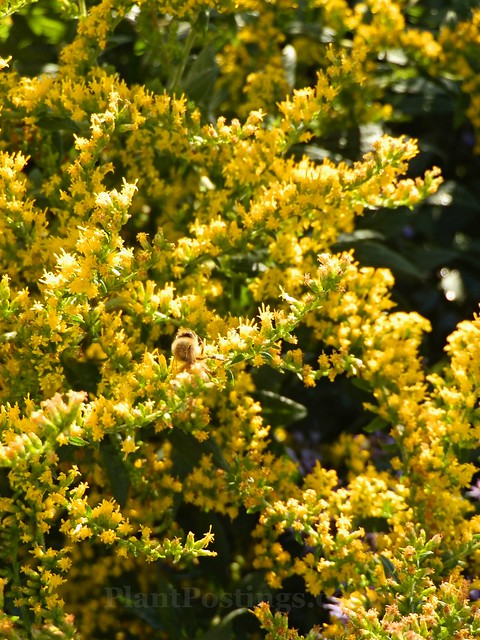
When it first starts blooming, the arching stems have just a hint of gold, and look like sparks of fireworks. At full-bloom, it forms a mound of lovely goldenness. The height and spread (depending on spacing) are roughly equal, at about 3 to 5 feet in both directions.
This Goldenrod grows best in sun, in medium-to-wet but well-drained soil. It's native from Ontario, Canada, south through Texas, U.S., and points east. Other nicknames include Rough, Rough-Stemmed, or Roughleaf Goldenrod.
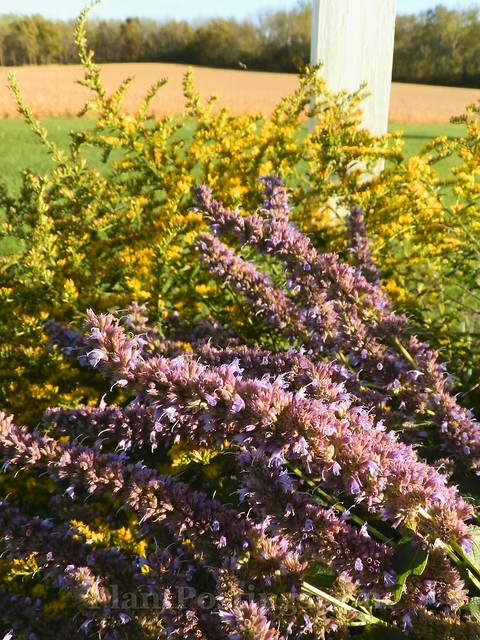
The color and form make it a great companion to Anise Hyssop (Agastache foeniculum).
But my favorite aspect of this beautiful late bloomer is its value to pollinators--as it attracts butterflies, and is listed by The Xerces Society as "special value" to native bees and honeybees, and it supports conservation control.
The pollinators were enjoying it late into the growing season, when it was in its full glory and many other blooming plants were fading.
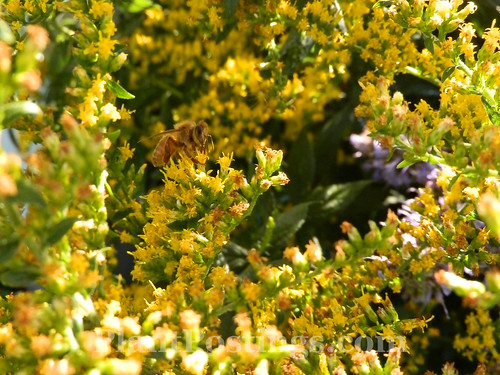
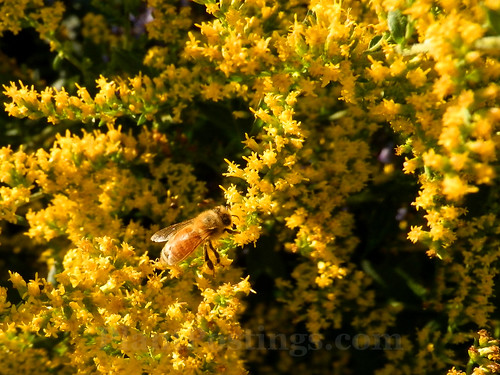
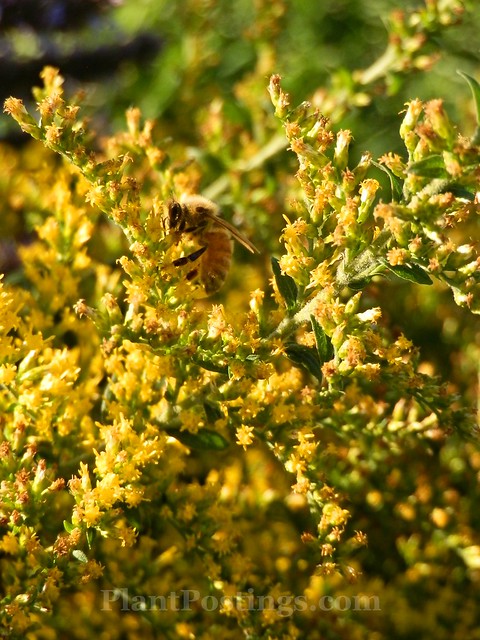
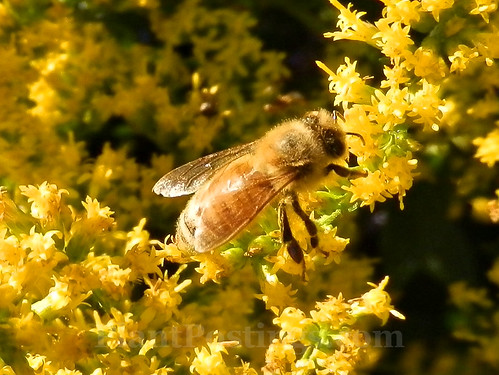

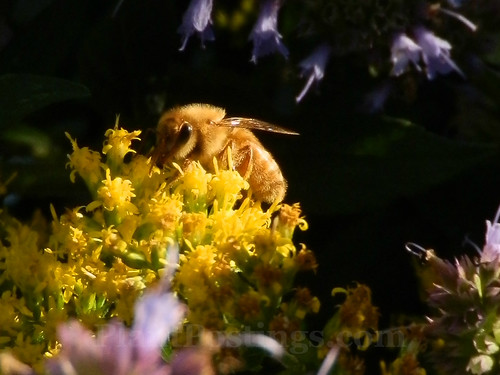
Beth, this is one of my favorite goldenrod in our garden. It stays fairly controlled as opposed to other goldenrod that just seed everywhere. And it is the latest one to bloom, although it is done now. I also agree that the pollinators swarm all over it! Happy Halloween....
ReplyDeleteDonna: I didn't know much about it until we planted it in the pollinator garden. It was in bud stage for quite a while as other Goldenrods were blooming all around the area. I was worried it wouldn't actually bloom, and then it exploded with bright yellow in early October. 'Fireworks' is a very good name for it. If I had a sunny garden, myself, I would definitely include this plant! Hope you had a great Halloween!
DeleteGreat photos and a wonderful plant to highlight.
ReplyDeleteI don't have it in my own garden (yet!) but I hope to add it someday soon.
Meanwhile, I saw an amazing mass planting of it at Yew Dell in Kentucky back in late August / early September. http://www.gardenofaaron.com/2014/09/an-august-visit-to-yew-dell-pomegranate.html
Hope you had a Happy Halloween and welcome to November! Let the wild winter rumpus begin :P
Thanks, Aaron. I've always enjoyed Goldenrods, and felt a little sad when they fell out of favor when people thought they were the cause of allergies. I hope people realize now that what they're sneezing at is something else that blooms at the same time. I'm going to have to look back at your post about this one. It seems familiar, but maybe I missed it? In any case, yes, masses of it are gorgeous. Halloween was fun--a little cold here, so I still have half of the candy left. Uh oh. Hope your Halloween was bright, too!
DeleteThis flower is an old fashion cut flower here. But we still find it sold on the florists, and only grown by traditional farmers. I think it's great for filler on the flower arrangement. Thanks for sharing this information!
ReplyDeleteYes, Goldenrods are great cut flowers! For many years here in the states, people thought it caused allergies so they stayed away from it and it was hard to find in stores. Now we can sometimes find Goldenrod in the stores and florists, and various species and varieties of Goldenrod grow wild all around the U.S.--mostly late summer through fall. It is beginning to become a popular native garden plant. :)
DeleteAny plant that blooms this late in the year is worth growth I feel Beth. Love the combo with the Agastache, wonderful!
ReplyDeleteGreat pictures, particularly the bees.
Thanks, Angie! I agree: This particular species was the latest-blooming one I noticed this year. Perhaps it was because these were new plants? I don't have enough personal history with it to know, but I guess I'll find out next year if I work on this garden again. The Agastache also seemed long-blooming--actually the longest blooming plant in the garden, from mid-summer through and beyond the first frost.
DeleteIt's interesting how many shapes Goldenrod comes in. I have a bunch of different varieties growing wild in my yard. One of these years I'll learn the names of all the various ones growing. The bees sure love them! That's great to have a variety that blooms later for them.
ReplyDeleteYes, so true Indie. I find them difficult to learn, myself. They all have that beautiful bright yellow, but the forms are all so unique. I just added Zigag Goldenrod to my garden this year. Some type of critter nibbled on it, so I hope it will grow back next season! I don't have enough sun to add most Goldenrods here, but I do enjoy their bright color and pollinator value in late summer/early fall!
DeleteI also have goldenrods in the garden, I love it as a cutting flower. But here they have gone already and I have cut them back otherwise I get to many of them next year.
ReplyDeleteThey're done here, too. These photos were from earlier in October, but still late in the growing season for peak-bloominb flowers. I'll bet they're really pretty in your garden when they're blooming! :)
DeleteThat bud stage is its moment of glory in the beauty department. Then the bees take over so I never cut it back one it's past its prime.
ReplyDeleteI agree! The bees were loving it in mid-October. But I think the prettiest stage is just before the flowers burst open! Bright yellow buds popping across the tops of the branches--very pretty!
DeleteWhat a great plant and to see so much colour at this time is wonderful, the bees and insects will be enjoying them too..Lovely photos.
ReplyDeleteAmanda xx
Yes, it was great to seem them still blooming so wonderfully in mid-October. Of course, they're finished blooming now and we're heading for winter and dormancy, but they were gorgeous while they lasted. And the pollinators liked them, too! :)
DeleteHi Beth, it's good to back visiting after a blogging break. Great bee photos. Golden Rod not so popular here, I think because its profuse pollen can aggravate allergies.But it's a shame, it puts on a stunning display of gold.
ReplyDeleteHi Sue: Welcome back! I'm happy that you enjoyed your break, but glad to read new posts from you. It's always so encouraging to read about spring/summer in the Southern Hemisphere as we head into winter. People here in the states used to think they were allergic to Goldenrod, too, but it turns out it's highly unlikely--and more likely they're allergic to something else (like Ragweed here in the U.S.). Here's an article that explains it:
Deletehttp://www.mnn.com/health/allergies/stories/dear-allergy-sufferers-dont-blame-goldenrod. Thanks for your kind comments, Sue. :)
Beautiful captures of the bees, Beth! I would add this to my own garden, but I have so many volunteers of the taller goldenrod that I don't think I need any more. But we do have this goldenrod in the nursing home garden, too, and I like its form as well as its color.
ReplyDeleteThanks, Rose! I guess that's one benefit of having a shade garden. I didn't have any Goldenrod here until I planted some of the Zig-zag (which tolerates shade) this year. Some little critter munched on it, though, so I don't know if it's going to make it. The 'Fireworks' Goldenrod is perfect for the sunny pollinator garden, though. Sounds like the nursing home garden you work on must be lovely!
DeleteI have both plants as companions too. Also my goldenrod is with asters and Russian Sage. The blue and yellow make great companions, plus the bees are happier when plants are paired like you have shown. Like Rose, I get too many goldenrod seedlings(all hybrids too) all over the garden. I would only suggest it for larger gardens. I do enjoy it for the late season feeding of pollinators though, it just needs work to keep it contained. Deep rooted, it is hard to remove too.
ReplyDeleteSounds gorgeous, Donna! I hope the Goldenrod doesn't take over the pollinator gardens I worked on. I doubt it will because the other plants are very sturdy native plants, too. And the bloom times are staggered from early spring through late fall. Good to know, though, if I ever plant it in my own garden in the future.
DeleteThese plants and bees are all so beautiful
ReplyDeleteand you captured them beautifully in your photos.
http://roomsofinspiration.blogspot.com/
Thank you, Ann. The scene was beautiful before my eyes, I must say. It's rewarding to build pollinator gardens and then see the pollinators come in droves to visit! :)
DeleteThat’s a lovely plant, I am not sure I have seen this one before for real, but I have seen it online at nurseries. I usually just quickly skim over those sun-hungry plants and go straight to the ‘shady’ section. It looks beautiful in your photos, it is called Golderod over here too.
ReplyDeleteI'm the same way about generally skipping over the sun-hungry plants, Helene--for most of my own garden. And you have more sun than I do--at least during the growing season. Now most of our deciduous trees in this area have lost their leaves and the only plants still green are the conifers and a few other evergreens and late-season leaf-droppers. So my garden will be sunny (albeit cold) until May. ;-)
DeleteI love goldenrod for all the reasons you mentioned. We have wild goldenrod growing on a hillside beside our drive, along with native asters and other wildflowers. We planted none of it, but it is as lovely as if I had carefully planned it.
ReplyDeleteBy the way, congratulations on four years in the blogosphere! That is an accomplishment!
Thanks for the congrats! Lucky you, Deb! As I mentioned to Helene, my garden is mostly shady during the growing season. I do have that small potager garden, but it's jam-packed with veggies and a few favorite perennials and annuals. That's why it was fun to work on a sunny pollinator garden as a volunteer this summer!
DeleteIt is refreshing to see your garden still in colors...but here in Minneapolis, I have to say we have had an extended summer too! We are just barely getting chillier weather, and the leaves have put on their last show this weekend. But what I love here is that sweet bee....doing her thing. I LIKE THEM (of course, from a safe distance!)
ReplyDeleteThank you dear lady, for coming to read my post. May you enjoy every moment of life that sets your imagination on fire! Anita
My garden is no longer colorful, sadly (well, the colors are more muted now). These photos were taken earlier in October at a pollinator garden I worked on this past growing season. Still, it was thrilling to see them still blooming in mid-October! The bees are fabulous and essential, aren't they?! Trying to help in the effort to keep them healthy and well-fed so they'll return the favor to us humans. ;-) (I absolutely love your blog, Anita.)
DeleteI have solidago caesia, a southeastern native that grows in dry shade. I love the goldenrods because they're so tough and useful. Excellent plant to highlight. :o)
ReplyDeleteThat looks like a lovely Goldenrod, too. I have to admit I have trouble differentiating some of the Solidagos, but S. caesia looks like a unique one--PLUS it looks like it's hardy in my zone and tolerates shade. Thanks for the info! S. rugosa 'Fireworks' has a unique form and bloom style, too. If I had more sun in my own garden, I would plant it for sure.
DeleteI always love seeing a happy honeybee. Your photos are awesome.
ReplyDeleteThanks, Grace! I was pleased to see so many happy honeybees and native bees there so late in the season. I guess the pollinator garden was doing its job. :)
DeleteOooh, now you've got me thinking, I wonder if I could squeeze one in to my park border... Gorgeous, a cloud of nectar-rich sunshine.
ReplyDeleteYes, that's a great way to describe it, Janet! It's a cheery plant, that's for sure, and a good cut flower, too.
DeleteI keep seeing Solidago on American blogs and I have been surprised to see how many there are. This is a lovely one, and it looks gorgeous with the Agastache.
ReplyDeleteI admit I can't keep track of all the Solidagos! Some of them look very similar, and more than 20 species are native to my state, alone! S. rugosa 'Fireworks' is unique, though--especially just before it's in full bloom. I'll try to capture a photo of that stage next summer. It's gorgeous!
DeleteThat is a nice looking goldenrod. The whole world must look golden from a bee eye view.
ReplyDeleteGood point! If they could see the full spectrum of the yellow, it must be overwhelming when they're surrounded by it. In any case, to be surrounded by that much "food" must be enjoyable. :)
Delete